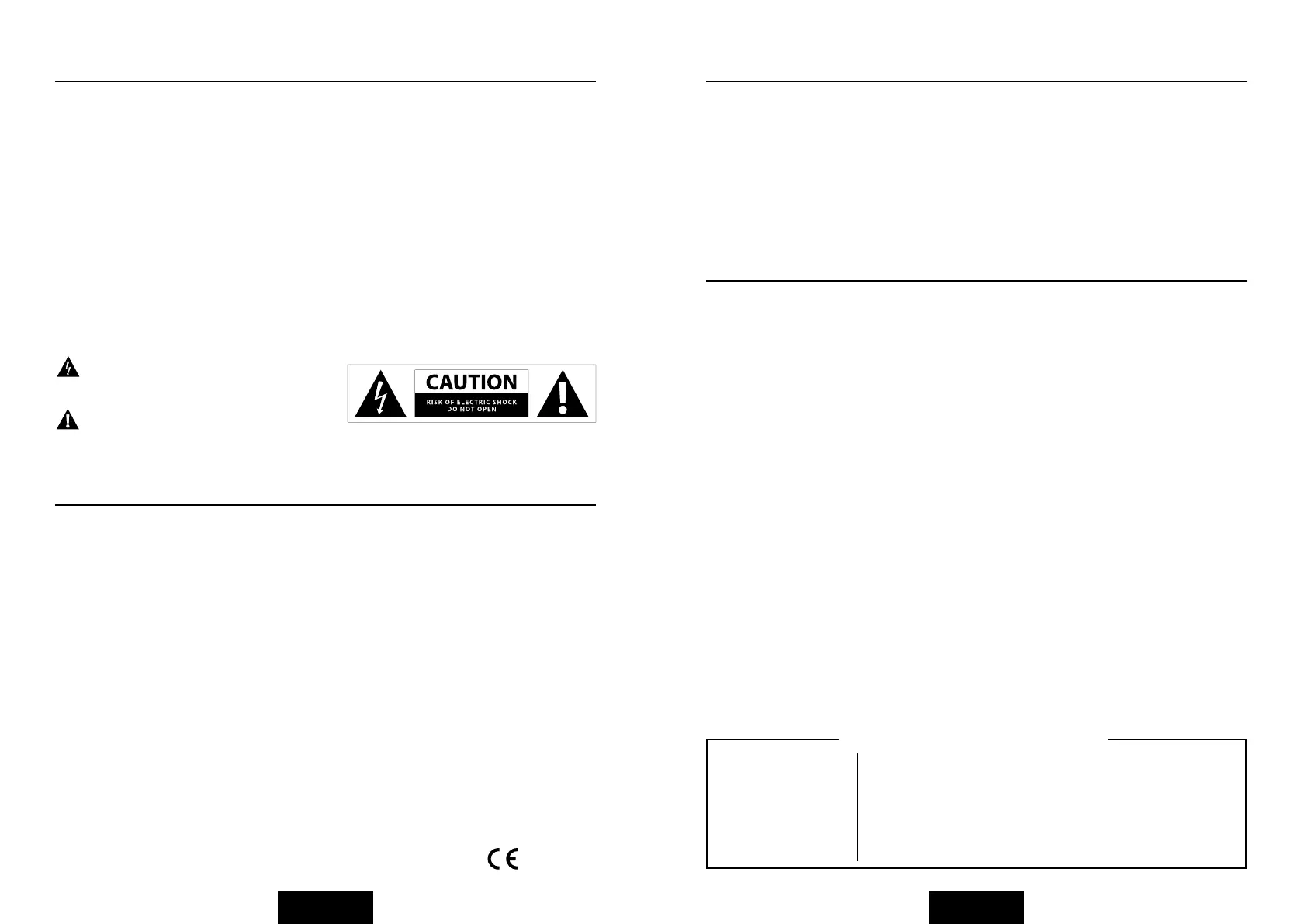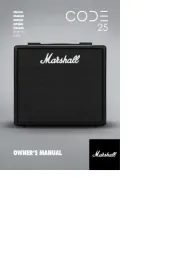Marshall Code 25 Handleiding
Marshall
Versterker
Code 25
Bekijk gratis de handleiding van Marshall Code 25 (69 pagina’s), behorend tot de categorie Versterker. Deze gids werd als nuttig beoordeeld door 211 mensen en kreeg gemiddeld 4.3 sterren uit 106 reviews. Heb je een vraag over Marshall Code 25 of wil je andere gebruikers van dit product iets vragen? Stel een vraag
Pagina 1/69

OWNER’S MANUAL
ENGLISH
FRANÇAIS
DEUTSCH
ESPAÑOL
ITALIANO
简体中文
日 本 語

INTRODUCTION
OVERVIEW
WARNING! IMPORTANT SAFETY INSTRUCTIONS
1) Read these instructions.
2) Keep these instructions.
3) Heed all warnings.
4) Follow all instructions.
5) Do not use this apparatus near water.
6) Clean only with dry cloth.
7) Do not install near any heat sources
such as radiators, heat registers, stoves, or
other apparatus (including ampliers) that
produce heat.
8) Do not defeat the safety purpose of
the polarized or grounding-type plug. A
polarized plug has two blades with one
wider than the other. A grounding type
plug has two blades and a third grounding
prong. The wide blade or the third prong
are provided for your safety. If the
provided plug does not t into your outlet,
consult an electrician for replacement of
the obsolete outlet.
9) Protect the power cord from being
walked on or pinched particularly at plugs,
convenience receptacles, and the point
where they exit from the apparatus.
10) Only use attachments/accessories
specied by the manufacturer.
11) Unplug this apparatus during lightning
storms or when unused for long periods
of time.
12) Refer all servicing to qualied service
personnel. Servicing is required when
the apparatus has been damaged in any
way, such as power-supply cord or plug
is damaged, liquid has been spilled or
objects have fallen into the apparatus,
the apparatus has been exposed to rain
or moisture, does not operate normally, or
has been dropped.
13) WARNING: To reduce the risk of
re or electric shock, do not expose this
apparatus to rain or moisture.
14) The appliance coupler is used as the
disconnect device, the disconnect device
shall remain readily operable.
15) The apparatus shall not be exposed to
dripping or splashing and that no objects
lled with liquid, such as vases, shall be
placed on the apparatus.
This “bolt of lightning” symbol indicates uninsulated material
within your unit may cause an electric shock. For the safety
of everyone in your household, please do not remove product
covering.
The “exclamation point” calls attention to features for which
you should read the enclosed literature closely to prevent
operating and maintenance problems.
COMPLIANCE STATEMENT
This device complies with Part
15 of the FCC Rules.
Operation is subject to the
following two conditions: (1)
This device may not cause
harmful interference, and (2)
This device must accept any
interference received, including
interference that may cause
undesired operation.
Warning: Changes or
modications to this unit
not expressly approved by
the party responsible for
compliance could void the
user’s authority to operate the
equipment.
Note: This equipment has been
tested and found to comply
with the limits for a Class B
digital device, pursuant to
Part 15 of the FCC Rules.
These limits are designed to
provide reasonable protection
against harmful interference in
a residential installation. This
equipment generates, uses and
can radiate radio frequency
energy and, if not installed
and used in accordance with
the instructions, may cause
harmful interference to radio
communications. However,
there is no guarantee that
interference will not occur
in a particular installation. If
this equipment does cause
harmful interference to radio
or television reception, which
can be determined by turning
the equipment off and on,
the user is encouraged to try
to correct the interference by
one or more of the following
measures:
- Reorient or relocate the
receiving antenna.
- Increase the separation
between the equipment and
receiver.
- Connect the equipment into
an outlet on a circuit different
from that to which the receiver
is connected.
- Consult the dealer or
an experienced radio/TV
technician for help.
This equipment complies
with FCC RF radiation
exposure limits set forth for an
uncontrolled environment. This
equipment should be installed
and operated with a minimum
distance of 20 centimeters
between the radiator and your
body.
Industry Canada caution.
This device complies with
Industry Canada licence-
exempt RSS standard(s).
Operation is subject to the
following two conditions:
(1) This device may not
cause interference, and (2)
This device must accept
any interference, including
interference that may cause
undesired operation of the
device.
Francais:
Le présent appareil est
conforme aux CNR d’Industrie
Canada applicables aux
appareils radio exempts de
licence.
L’exploitation est autorisée aux
deux conditions suivantes:
(1) l’appareil ne doit pas
produire de brouillage, et
(2) l’utilisateur de l’appareil
doit accepter tout brouillage
radioélectrique subi, même si le
brouillage est susceptible
d’en compromettre le
fonctionnement.
2200
ENGLISH ENGLISH
Power (RMS)
Presets
Speaker
Footcontroller
Weight
Size (in mm)
Connectivity
25 Watts
100 User editable Presets
10” Custom Voiced
4-Way Programmable (PEDL-91009, Sold separately)
8 kg
350 x 340 x 215
Bluetooth
®
4.0 & USB 2.0
CODE25 TECHNICAL SPECIFICATION
CODE is a new generation of Marshall amplier. Fully programmable, CODE combines
authentic modelling of classic and contemporary Marshall tones with professional
quality FX. CODE preamp, power amp and speaker cabinet models have been developed
in collaboration with audio software pioneers Softube to create Marshall-Softube
(MST) modelling. Featuring Bluetooth
®
& USB connectivity, and Marshall Gateway™
compatibility, CODE is a powerful tool that lets you make music your way.
CODE is loaded with sonic possibilities. It has 14 MST preamps, 4 MST power amps
and 8 MST speaker cabinets. CODE features 24 FX: including Compressor, stompbox
Distortions, Auto Wah, Pitch Shifter, Chorus, Vibrato, Phaser, Vibes, Flanger and Tremolo.
It includes Studio, Vintage, Multi and Reverse Delays, Tap Tempo, and studio quality
Reverbs. Including Gate, you can have up to 5 FX simultaneously.
Using the Marshall Gateway App for your iOS or Android device you can control CODE’s
settings remotely via Bluetooth and share Presets with other CODE users. You can stream
audio from your device, computer or MP3 player through CODE’s speaker or headphones
for practice, or jam along with tracks from your music library. Connect via USB to use your
CODE amplier as a DAW interface.
We sincerely hope that you enjoy your CODE amplier and we wish you every success,
whatever your performance situation. Thank you for choosing Marshall.
- The Marshall Team
Product specificaties
| Merk: | Marshall |
| Categorie: | Versterker |
| Model: | Code 25 |
Heb je hulp nodig?
Als je hulp nodig hebt met Marshall Code 25 stel dan hieronder een vraag en andere gebruikers zullen je antwoorden
Handleiding Versterker Marshall

16 September 2023

16 September 2023
Handleiding Versterker
- Rotel
- Luxman
- Onkyo
- Elektra
- Behringer
- NAD
- Samson
- MaxGear
- Iriver
- Geemarc
- Marantz
- Fenton
- Yamaha
- Zoom
- Beyerdynamic
Nieuwste handleidingen voor Versterker

24 December 2023

24 December 2023

15 September 2023

17 September 2023

15 September 2023

15 September 2023

15 September 2023

15 September 2023

15 September 2023

15 September 2023